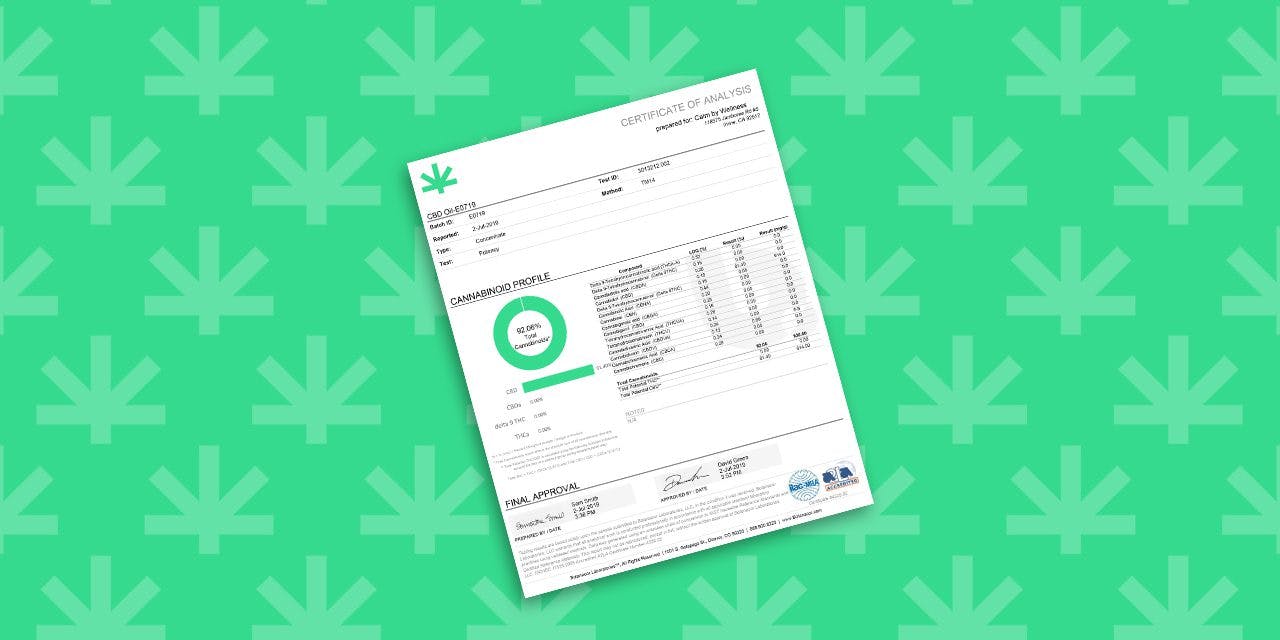How to Read a Marijuana Certificate of Analysis

Article written by

Shanti RyleContent Writer
Content reviewed by

Dr. Lewis JasseyMedical Director - Pediatric Medicine
Nearly 80% of the United States has legalized some form of medical marijuana to date. Yet, the regulated industry is still very young. Each state is responsible for regulating its legal market, and this includes implementing and maintaining safe quality standards.
A certificate of analysis (COA) is proof that a cannabis product meets the state’s quality assurance and safety standards and deems that product safe for consumption. These certificates are often on product labels or published on a brand’s website and offer transparency into the contents and quality of a cannabis product.
As a consumer, it’s essential to know how to read these certificates to know exactly what’s in your cannabis product. Read on to learn where to find a marijuana certificate of analysis and how to interpret its contents.
Get your medical marijuana card
Connect with a licensed physician online in minutes.
What Is a Marijuana Certificate of Analysis?
A COA is a document produced by a third-party, accredited laboratory following a sample cannabis product testing. The test results outline important pieces of information, including cannabinoid profiles, terpene content and the presence of any contaminants such as heavy metals, microbes, pesticides or fungi.
Analysis certificates are essential in the transparency between brands and consumers, helping to establish trust in a product’s quality. A lab-produced COA is even more valuable because the cannabis testing results come from an unbiased third party stating the facts and nothing more.
Every state-regulated cannabis program requires third-party laboratory testing to prove certain aspects of cannabis products, usually cannabinoid profiles and the presence of any pesticides and other potential contaminants.
On the other hand, CBD is federally legal but not federally regulated, with no such requirement by producers to submit their products for testing. While some reputable CBD products include lab results, many companies don’t test at all. Others still label their products with miscalculated potency levels or even fail to report cannabinoid content whatsoever. One study found that several CBD products in a sample even contained federally illegal THC.
What does a Certificate of Analysis Show?
A certificate of analysis shows basic pertinent information, such as:
- Lab name
- Lab accreditation and location
- Date of sample receipt
- Date of sample test
- Product type
- Lab “batch” number
- Producer who requested the test.
COAs focus on product phytochemical content and safety results, with the authorization of a COA serving as the signature of a certified inspection by the testing lab. COAs may often appear as a QR code on the side of a product label, which consumers can scan to find more information.
When examining a COA, double-check if the date and batch number match your purchased product. If they don’t, it may be a sign the brand is behind on its testing or publishing newer results. It’s also helpful to confirm that the laboratory has an ISO/IEC standard 17025 certification to ensure the lab follows best practices and testing procedures.
Here’s the basic breakdown of what information you’ll find on a COA.
Cannabinoid Concentration
Cannabinoid concentration in a product showcases the levels of different cannabinoids, such as THC, CBD, CBN and others. These potencies are shown by weight in milligrams and the percentage of the overall product.
Terpene Profile
Terpene profiles identify the unique terpenes and their concentrations by weight and percentage. Terpene makeup is increasingly important as consumers seek particular effects or sensory experiences from their cannabis.
Free Cannabinoid and Terpene Guide
Flavonoid Test Profile
Flavonoid tests are rarer but refer to the percentages and weight of flavonoids found in a cannabis product. We’re learning more about flavonoids, which have unique medicinal properties.
Genetic Testing
Genetic testing is an important element of a COA. Market-named “strains” have no consistency from producer to producer or even crop to crop and are therefore an unreliable method of achieving a reliable cannabis experience. The genetic makeup of cannabis cultivars is much more critical for achieving specific effects and for cultivators seeking to grow strains to address various concerns.
Microbiological Testing
Microbiological testing checks for mold or mildew content and is one of the most commonly required tests in state-regulated cannabis programs. Microbes can lead to the development of harmful mycotoxins. Testing can help identify the presence of these before a product arrives at a dispensary.
Synthetic Cannabinoids
Synthetic cannabinoids are artificial chemicals created to emulate the psychoactive experience of THC. They are sometimes mixed into various cannabis products or added to CBD to produce a “high.”
Some synthetic cannabinoids are much more potent than THC, and the body is ill-equipped to metabolize them. Safe CBD products should therefore include lab tests that verify the absence of anything but naturally occurring cannabinoids and plant materials.
Residual Solvents
Extractors often use solvents such as ethanol or BHO when creating cannabis concentrates to separate cannabinoids and terpenes from plant material. However, sometimes leftover solvents can remain in a product that isn’t adequately purified, which can put consumer health at risk. Most states require testing and results for residual solvents before dispensaries can sell the products.
Pesticides
Most states regulate pesticide use and require lab testing, though which pesticides and to what extent varies. However, cannabis absorbs and retains pesticides more than other plants, which presents a risk to consumers ingesting a product with lingering chemicals. A certificate of analysis will confirm if pesticide levels in a test product exceed those safe for human consumption.
Heavy Metals
Heavy metals can often exist in soil, water and other materials used to cultivate or process cannabis. Cannabis can be easily impacted by heavy metals such as lead or nickel at any stage of the process. As such, heavy metal testing is typically required by state law.
Water Activity
Some, but not all, COAs may include a section for water activity. The moisture content of a cannabis product refers to the total amount of water in the product. Higher water activity (above 0.85) means a greater likelihood of microorganisms appearing and will require refrigeration. Mid-range water activity (0.60-0.85) won’t need to be refrigerated but will have a limited shelf life. Anything below 0.6 will not require refrigeration.
Terms to Understand
- COA: Certificate of authenticity
- LOQ: Limit of quantification
- LOD: Limit of detection
The Bottom Line: Why Buying Products with a Certificate of Analysis Is Vital
COAs are essential for building trust between brands and consumers. The transparency they provide is vital for both compliance and reputation. Medical patients and recreational consumers alike can rest assured that they’re purchasing a high-quality product with the correct potency, terpenes and purity they’d want.
Get Your Medical Marijuana Card
Connect with a licensed physician online in minutes.

